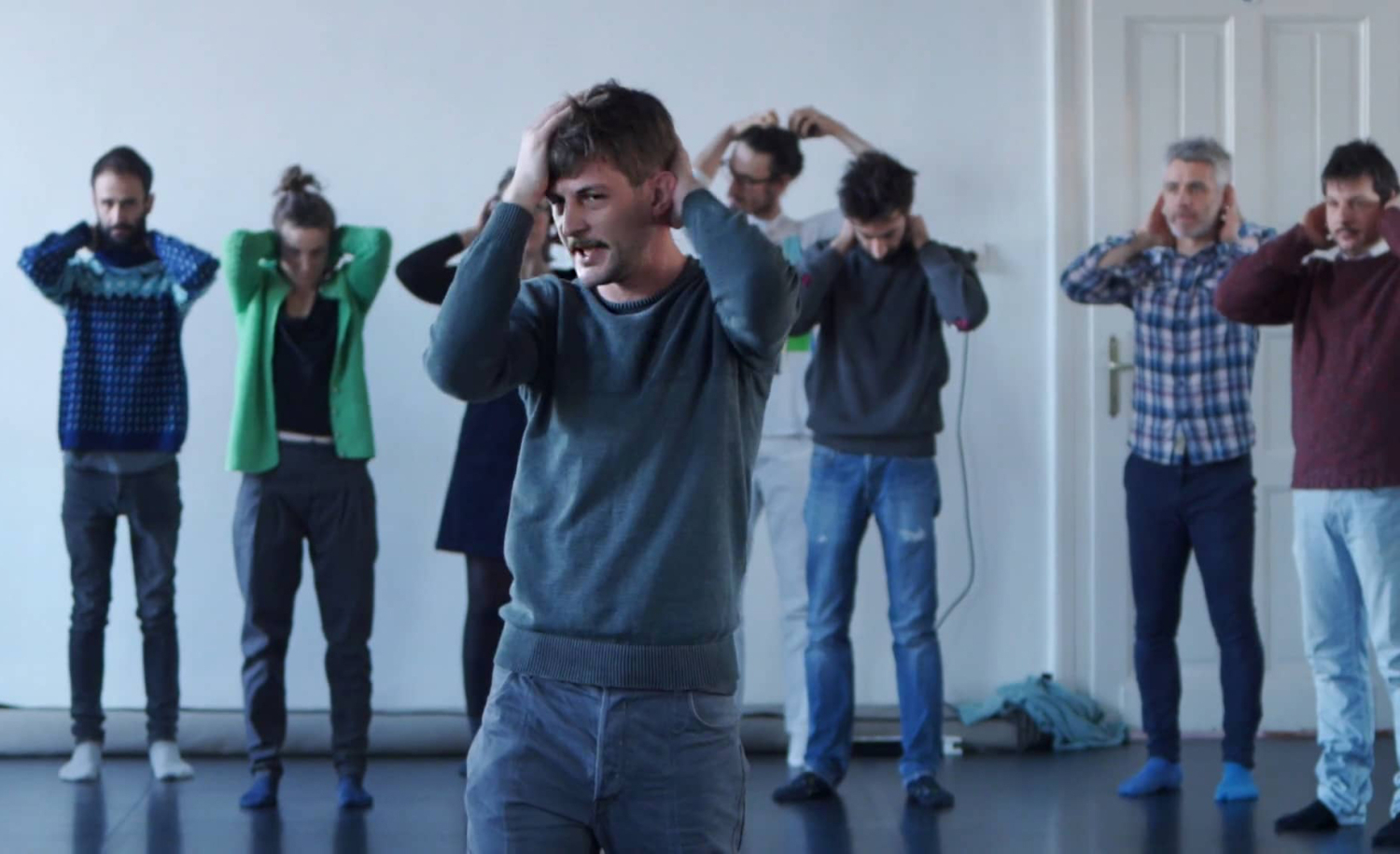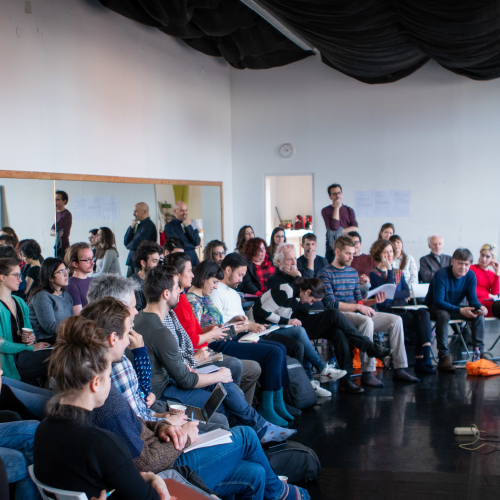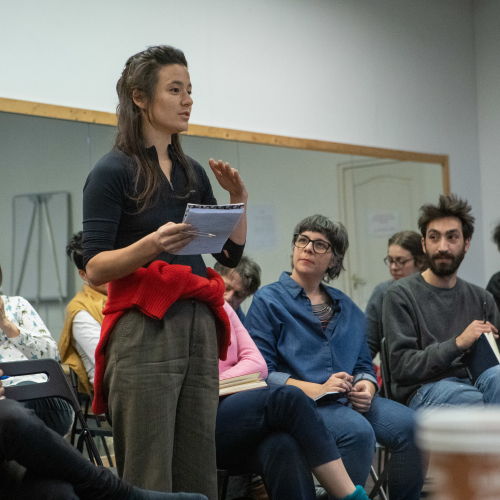

Yasen Vasilev shares his thoughts on the EDN Atelier on Mobility and Freedom of Expression held in January 2019 at Trafo, Budapest.


How to create alternatives and solidarity?
How to develop an art practice in times of uncertainty? After years of neoliberal policies which have damaged the sector and with right-wing governments gaining ground in Europe? How to create solidarity among the actors within the European dance field, when everyone is struggling to survive? How to create alternative ways of working together in order to respond to the economic and ecological crises?
These urgent and relevant questions were addressed in the EDN atelier on Mobility and Freedom of Expression, hosted by the three most important contemporary dance organisations in Budapest – Trafo, SIN arts centre and Workshop foundation. Visited by dancers, choreographers, programmers, producers and venue representatives from all over Europe, the two days consisted of open dialogue, expert talks and group working sessions on some of these complex questions. Structural problems in the field, political obstacles, alternative modes of production and the dynamics between Hungary and the larger European context were discussed in a non-hierarchical way.
Expand the "we"

Exploring the relationship between artists and venues
As someone recently put it: you can be an emerging artist until you’re fifty. That means you never actually emerge. Many artists feel they are left outside in the cold, facing ivory towers which they can not access and to which they have to beg for work. Their freelance contracts are not sustainable and there’s a huge amount of unpaid work surrounding projects. Paradoxically, the salaries of the technical team, the accountants and the ticket office are never put into question, yet the artists, without which these jobs and the institutions are made obsolete, are expected to make personal sacrifices for their art. There is an unequal relationship between venues and artists – Trafo’s executive director Gyorgy Szabo calls this a collide between a horizontal model of communication – which is the cooperative and collaborative way artists are working versus a vertical model of power where the programmers are seen as being “inside” the power to cherry pick projects while the artists are “outside” and don’t know how to enter.
But what programmers often feel is that their positions of power as gatekeepers, are actually similarly precarious because they have to re-apply yearly for their operating budgets, they can’t plan ahead, they are under constant pressure to augment ticket sales and attract new audiences, they have to follow specific themes and rules imposed by funding bodies and if they want to offer more to artists, they are often unable to do it. This needs to change – resources should be more evenly distributed, opportunities should be made more sustainable, career paths and conditions of entry to institutions should be transparent. A lot of people from the previous generations who fought for years to establish the institutions we have today are having a hard time to step down and share their power and resources with newcomers.
In order to counter that, the atelier offered a translation between the languages of gatekeepers and artists to “expand the We”, the sense of professional community. No matter if we’re dancers, performers, programmers, producers, managers, writers, critics, dramaturges – freelance or employed – starting now or in 1979 – we’re facing common challenges and we need to be working together to invent new strategies for changing times.
Share knowledge
Between national production and international circulation
Aniko Racz, a producer from SIN arts centre, described the current situation in Hungary as “survival mode” where space for research and experimentation is limited, programmers and venues are afraid to take risks, and everyone thinks about existence rather than development. The pressure to produce and premiere all the time and the large quantity of work – Budapest had 142 dance premieres last year – doesn’t necessarily mean a healthy and well developed local scene. According to the experts, the Hungarian scene still lacks infrastructure for local artists, so it’s easier and more secure for programmers to invite international acts. The Hungarian works mostly remain invisible and are shown no more than a few times, as both national and international circulation is difficult (even sometimes impossible) to obtain. In order to stay in the game, artists are asked to keep producing new and new works until they are burnt out.
While it might be more urgent in Hungary, this is an issue shared all across Europe. Often, Eastern Europeans feel that their Western peers cannot understand them and the post-socialist context they are evolving in. As a result there are many misunderstandings about each other: Eastern Europeans are seen as “constantly complaining” and “negative”, Westerners as “spoiled” and “privileged”. International collaborations are a way to go beyond these cliches, compare our local contexts, learn from each other by sharing knowledge and build collective strategies to promote our work at European level. International collaborations can also open up a space to discuss problems that might be tabooed by the local funding bodies and give a certain amount of freedom (despite the heavy bureaucratic work). It is also a way to appreciate and/or criticise our local contexts from a different perspective and understand our local political struggles as part of a larger picture.
Understand the Frame
Funding and freedom of expression
There are always voices trying to romanticise the “struggling artist” and explain that dealing with far-right governments automatically reinforces the art form and its impact.
In socially conservative Hungary where a big production can be taken down because pro-government newspapers accuse it of being “gay propaganda”, contemporary dance is referred to in some circles as “gay activity” but remains under the radar because of its diminishing audiences and therefore harmless impact. On the contrary, in liberal Holland, diminishing audiences are a major argument against state subsidies for the art sector which came to be known as the “left-wing hobby”, an expression that now serves to indicate the right’s contempt for what they consider an “elitist” practice in need of market democratisation.
Another opinion that generous funding won’t necessarily create better works because comfort doesn’t benefit good art, is open to debate but funding will contribute to conditions for a good work to potentially emerge. Live art, as opposed to literature for example, needs infrastructure to exist, and this should not be considered an unnecessary luxury. Maybe most divisive seems the question of funding: public or private. The argument against public funding says that dance and theatre artists are too dependent on the government which can censor them or push them to self-censor by imposing priority topics and themes in its funding programs, therefore artists should liberate themselves and become independent with alternative sources of income. The argument for public funding states that contemporary dance is a phenomenon of the welfare state in Europe and simply couldn’t exist without it, left alone to the destructive forces of the market.
In a society plagued by inequalities, freedom of expression is an illusion, especially in relation to the form of censorship imposed by the market principles applied to the art sector. In a situation where ticket sales are the measure of success and determine the public funding, independent voices are silenced even without censorship, experimental works are marginalised and big institutions start to follow the taste of the audiences instead of being leaders of opinion. In a context like this the creative industry might be booming and growing while at the same time artists might be suffering. Because there is no policy of censorship to blame, the responsibility for failing to produce work is transferred to the individual, while the economic ideology behind it remains hidden. Artists are constantly told they’re free and whatever they achieve or fail to achieve is their own responsibility only. We have to resist the idea of the artist as a cultural entrepreneur because the value of art lays beyond the economic field. There’s a wrong assumption that our choice has to be between either freedom or stability when we can actually have both.
Create alternatives
The relevance of our local communities
One strategy for changing times was proposed by the project in development Nibiru (by Hungarian artists Vadas Zsófia Tamara, Gryllus Ábris and Tóth Márton Emil) – parts of which we saw in rehearsal on the second day of the atelier. A working method to develop dance works with school-age girls, it can be re-applied in different contexts with different participants. Working with a new generation of non-professionals, it prepares the ground for a different appreciation of the arts, no matter if they decide to follow the path professionally or not. While it puts into question the role of the professional performer and adjusts to the current economic conditions rather than challenge them, it’s a smart way to keep doing work in a time where international circulation of artists, just like commodities, have become an imperative. It is not a choice and it is not a privilege, as it might seem seen through an instagram feed. On the contrary, artists are chasing funds and job opportunities by living nomadic lifestyles that are affecting their personal relationships and their ability to create a sustainable career and build audiences. The question for artists today is: Who can afford not to travel?
Both Marcio Kerber Canabarro and Anna Biczok – the two Budapest-based artists who took part as speakers in the first day of the atelier – brought this up as they reflected on the way in the past artistic communities have been tightly linked to a particular context, city or even venue (Judson church), while today there’s an ever-increasing rapid displacement. Uprooted individuals are not fully part of the local community, therefore there’s no one to protest their disappearance after the budget cuts. If structures and institutions of contemporary dance were to disappear tomorrow, who would notice beyond our little professional community, our friends and families? Budget cuts are more easily imposed when there is hardly anyone out there defending the art form.
Along with budget cuts and precarious working conditions, the other main issue we all struggle with is audience numbers – literally every presenter in Europe has a problem with that. It’s a problem for artists as well, because often they won’t get invited to present again if a piece didn’t sell enough tickets. Across Europe, contemporary dance festivals often feel like a bubble where professionals, artists, students and wannabes meet. Yet, the local audiences largely remain unaware of contemporary dance, unless it’s about a big name with an already established career. Instead of aspiring to become superstar artists as well, we need to try to repair the broken connections with our local communities.
Practice your preach
Finding alternative modes of participation
Living in a town with a population of 24 000 in Northern Ireland, dance artist and atelier participant Dylan Quinn was instrumental in developing the local dance scene and pushing the boundaries of what’s acceptable within a conservative community he knows well. His latest project about the positive and negative aspects of masculinity overcame an initial backlash from the community against nudity on stage. Instead of slamming this “backward thinking” as many would do, Dylan engaged in dialogue to explain and defend his work and succeeded where a visiting international artist might have failed. Moving back to the countryside is a strategy to avoid the machine of constant production and competition in big cities, as well as to build strong relationships and a long-term career. There was a consensus among the atelier participants that engaging the local community through workshops and outreach events increases their interest in the work and has a lasting effect on attracting new audiences. This should be done in an inclusive and respectful way and take into account the specifics of the local context to avoid being seen as an attempt of an “urban elite” to reconnect with the left-behind.
Along with other underground practices, there’s a current trend of rejecting big institutions in favour of a personal path in which one creates the rules and finds alternatives modes of participation (rather than production). Artists working with funding bodies can (un)consciously impose self-censorship to get grants, re-articulate and change their work to fit certain frames. The radical rejection of a career within established institutions is probably not changing the institutions themselves but it creates an alternative with less obligations to fulfill that is yet to be followed by more and more people.
Everything is Political: What Question is your Work Answering to?
The value of interdependence
In our dangerous times of division and detachment we see way too much hermetic work that deals with personal mythologies of self-expression. As Marcio put it, the ideology of our time celebrates individuality more than the community, but why do we celebrate independence and not interdependence? Contemporary dance is seen as elitist, distant and disengaged. If we want to continue to make relevant work, we need to take into account the seriousness and dangers of this situation and “burst the bubble”, open up our work to the world beyond our professional community and think of ourselves not only as artists but also as political subjects whose actions support or challenge the frame we’re operating in. Art probably cannot change the world, but political subjects can change both the world and art.
About the author
Yasen Vasilev (Bulgaria, 1988) is a poet, playwright and dramaturg, educated at the theatre academies of Sofia and Shanghai. He started his practice with two poetry collections transformed into spoken-word, followed by five theatre plays which received awards, residencies, publications, readings, workshops and productions internationally. Since 2015 he’s been working on NUTRICULA, a physical solo in collaboration with artists from different backgrounds and locations, shown in Shanghai, Lisbon, Vilnius, Turin and Sofia. He’s a contributing author for Springback magazine and works with Sfumato theater in Sofia.
Trafo House of Contemporary Arts and EDN present an Atelier exploring Expression of Freedom and Mobility in collaboration with the Workshop Foundation and SIN Culture Centre - 16-17 January 2019, Budapest, Hungary. They recorded the event in this video: